Abstract
The chemiosmotic model of energy transduction offers a satisfying and widely confirmed understanding of the action of uncouplers on such processes as oxidative phosphorylation; the uncoupler, by facilitating the transmembrane movement of protons or other compensatory ions, reduces the electrochemical proton gradient that is posited as the energy intermediate for many kinds of bioenergetic work. In connection with this formulation, uncoupler-resistant mutants of bacteria that neither exclude nor inactivate these agents represent a bioenergetic puzzle. Uncoupler-resistant mutants of aerobic Bacillus species are, in fact, membrane lipid mutants with bioenergetic properties that are indeed challenging in connection with the chemiosmotic model. By contrast, uncoupler-resistant mutants of Escherichia coli probably exclude uncouplers, sometimes only under rather specific conditions. Related phenomena in eucaryotic and procaryotic systems, as well as various observations on uncouplers, decouplers, and certain other membrane-active agents, are also briefly considered.
Full text
PDF
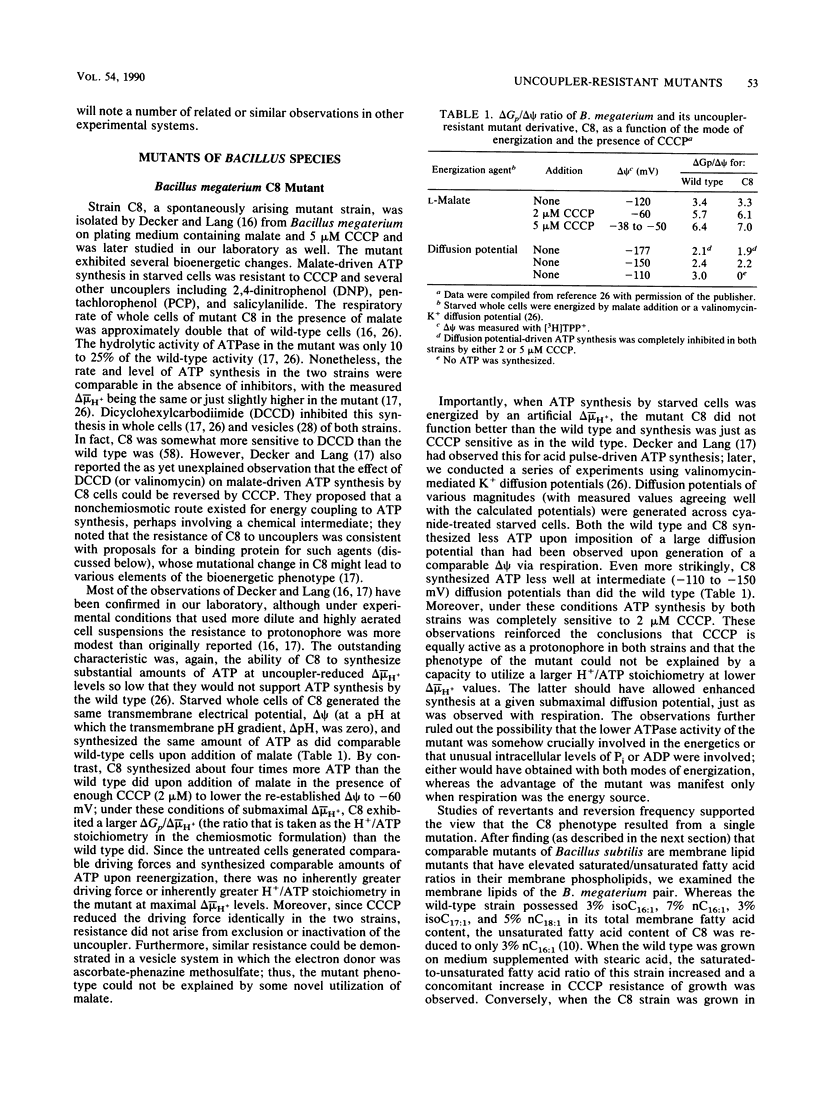


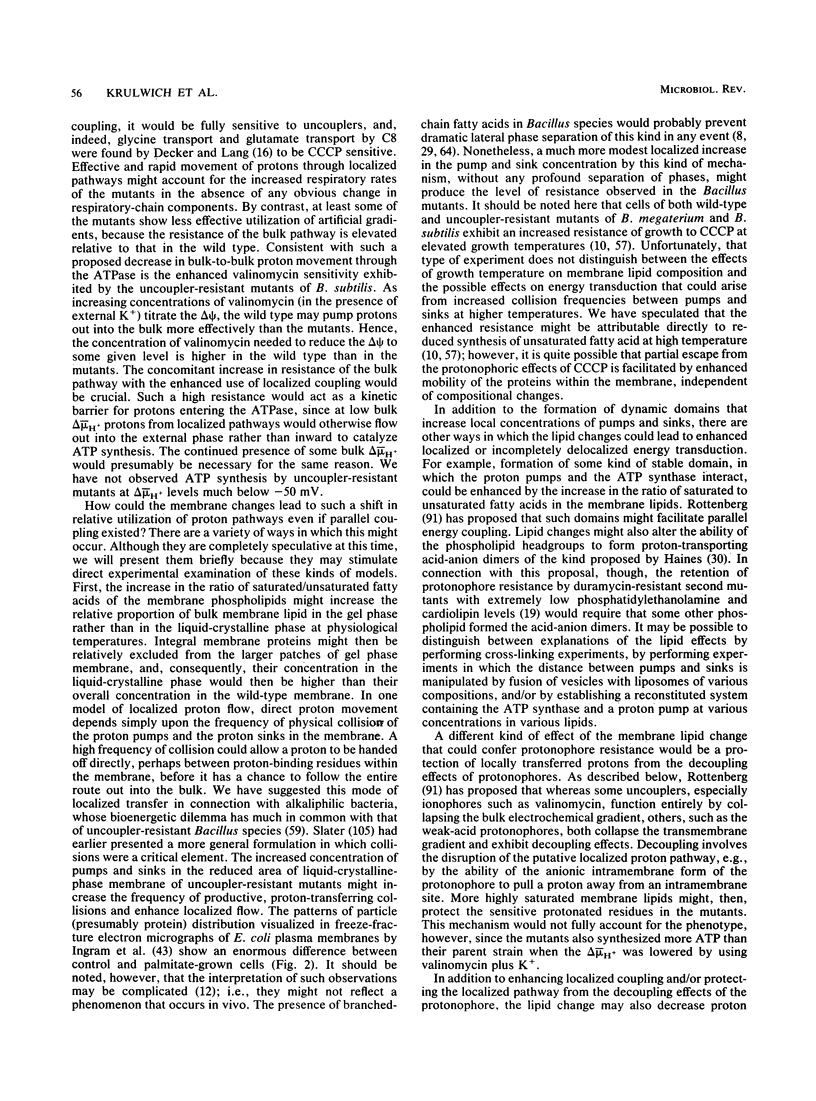
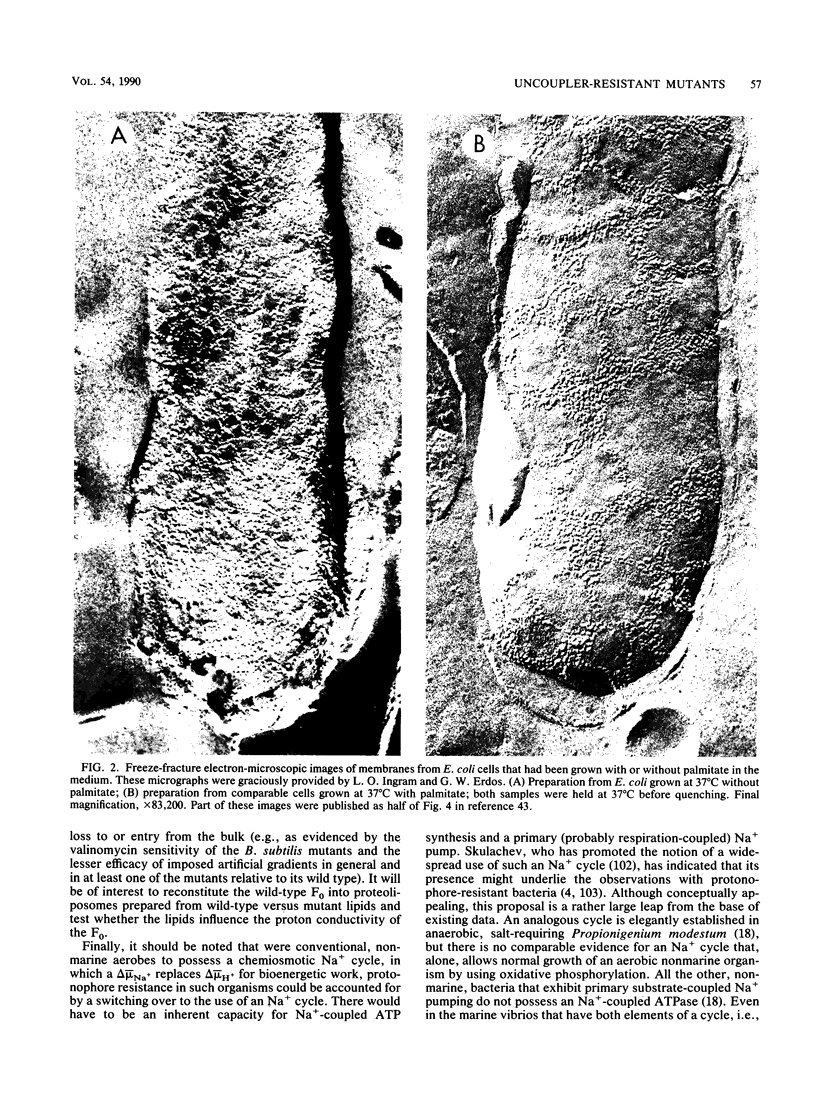
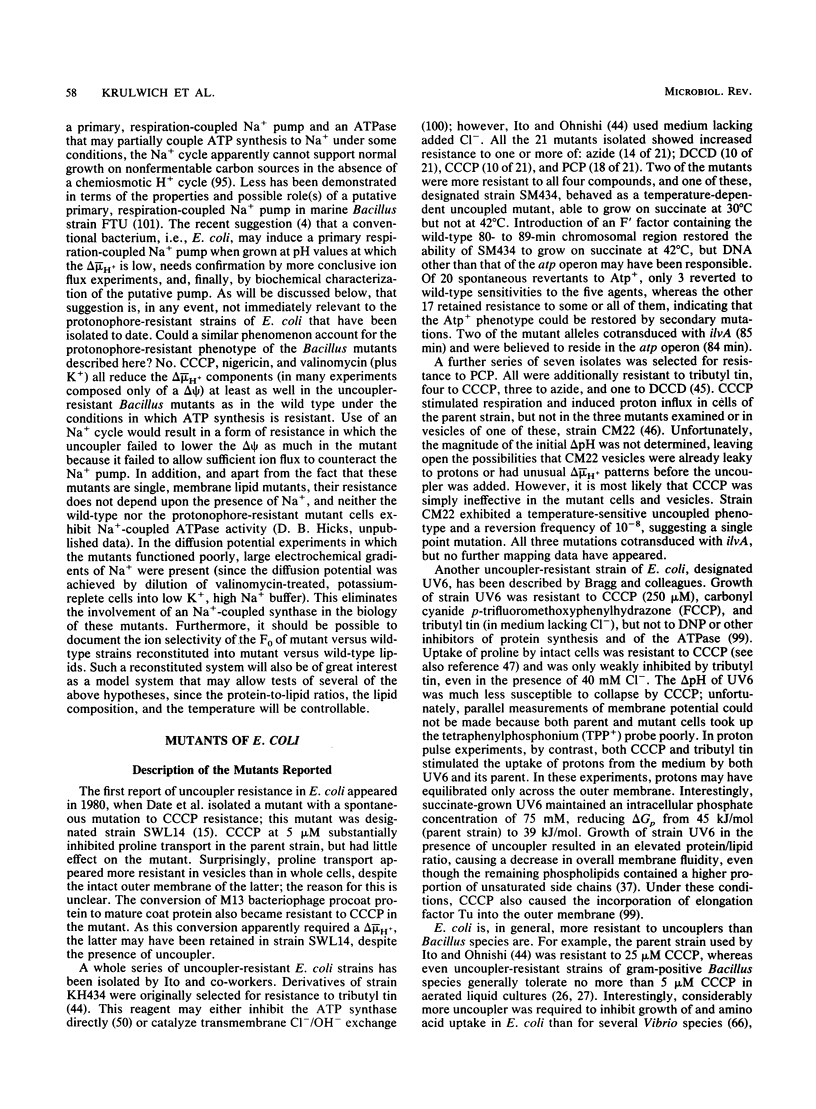
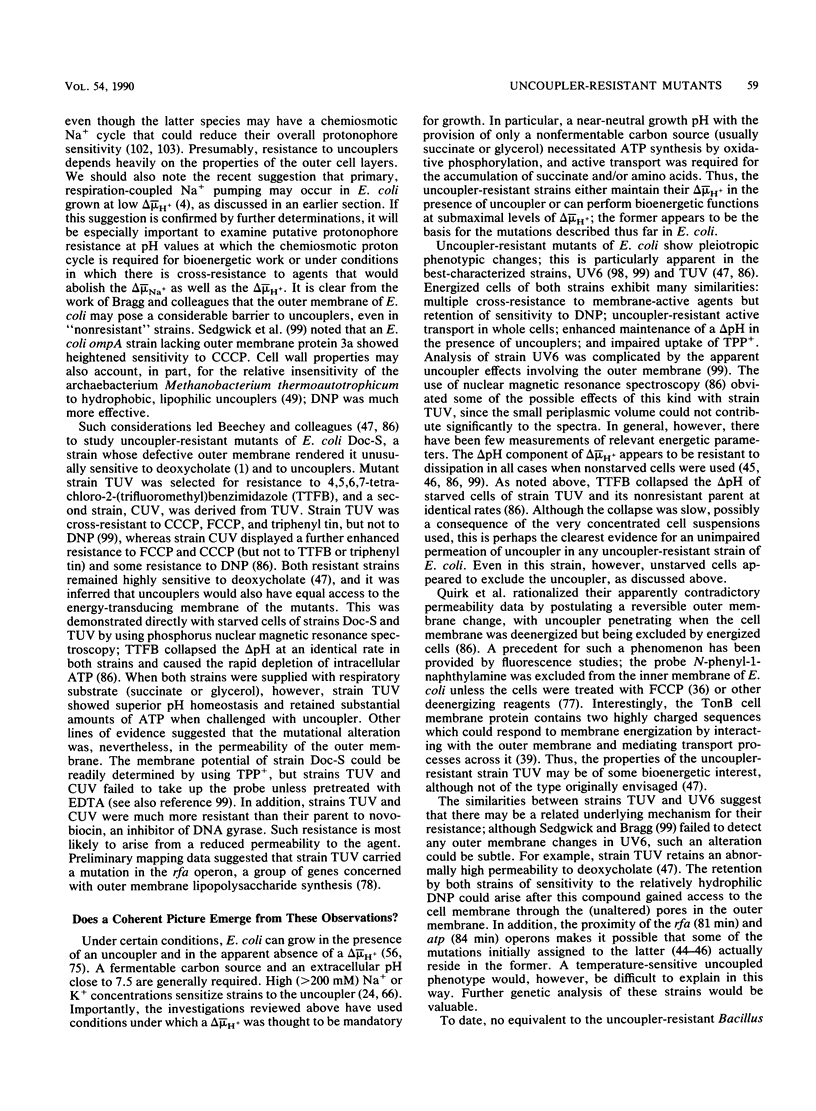


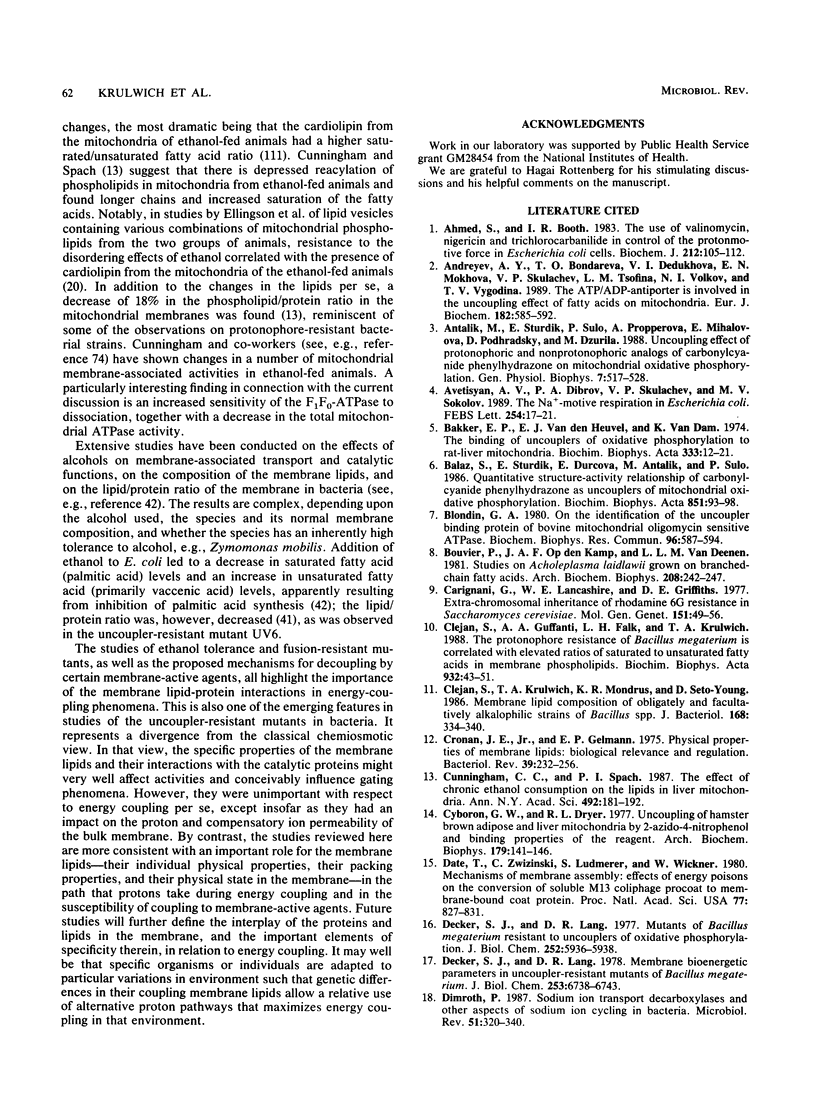

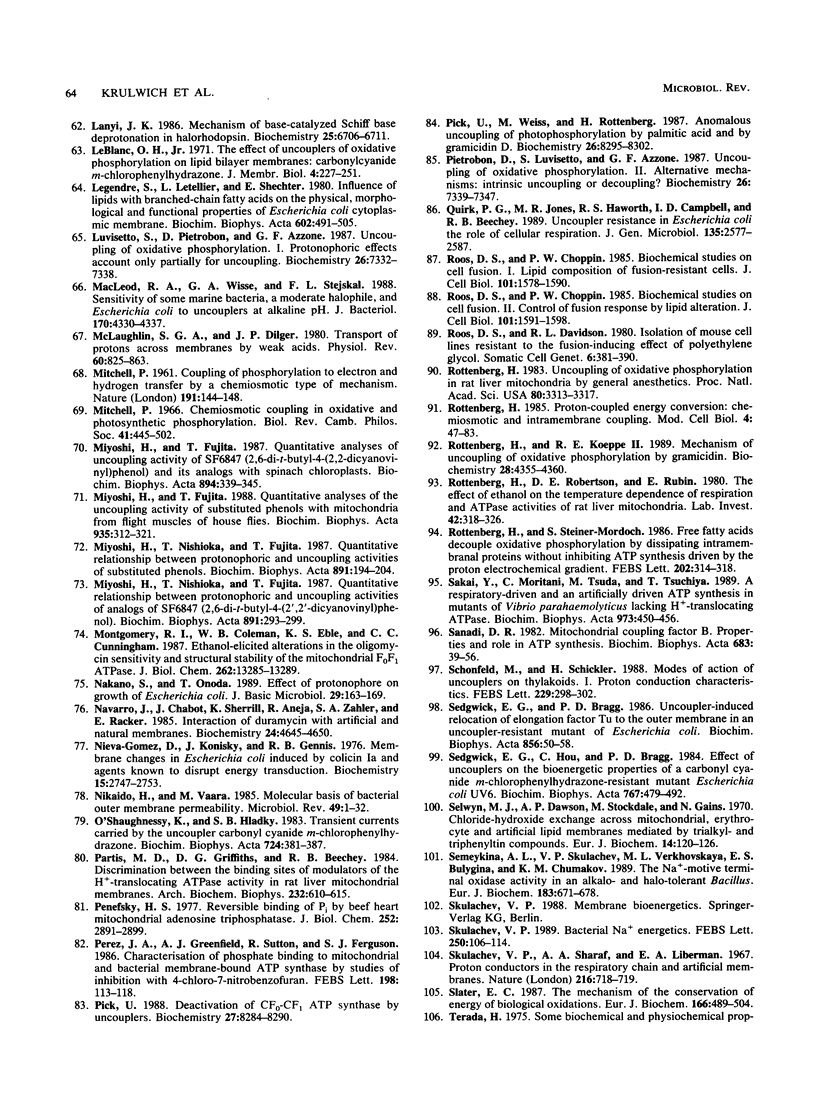
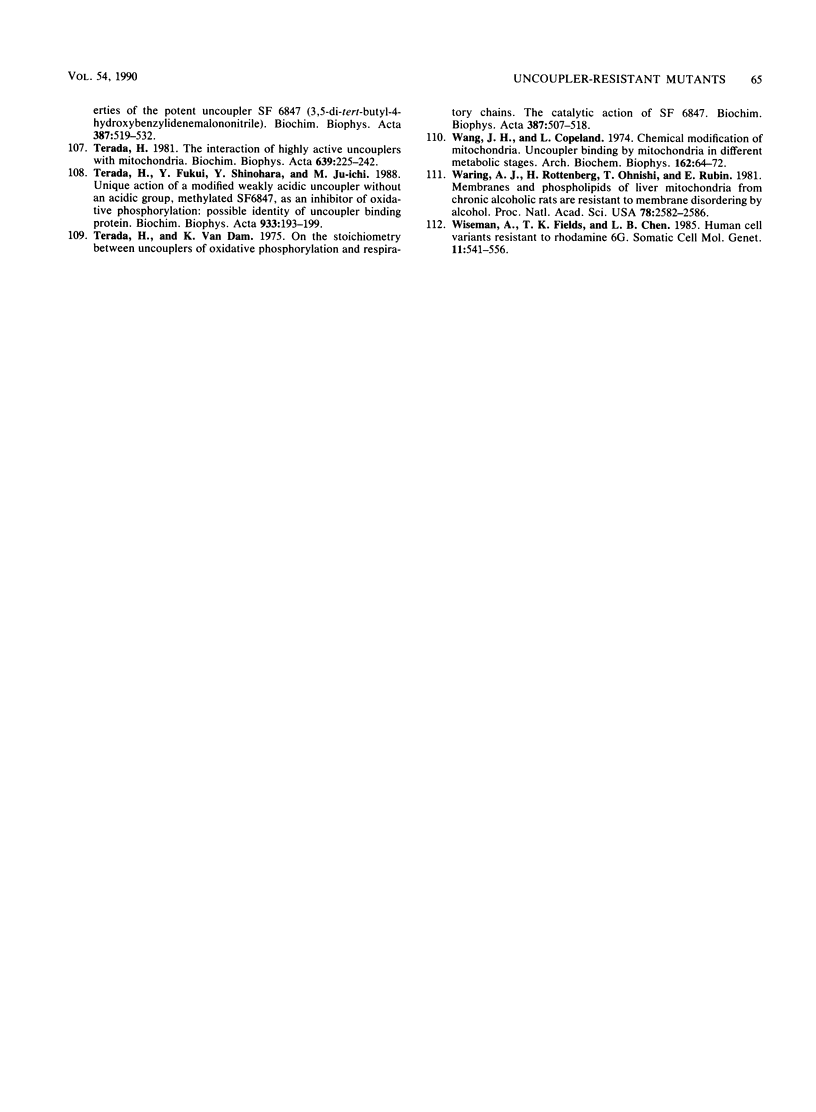
Images in this article
Selected References
These references are in PubMed. This may not be the complete list of references from this article.
- Ahmed S., Booth I. R. The use of valinomycin, nigericin and trichlorocarbanilide in control of the protonmotive force in Escherichia coli cells. Biochem J. 1983 Apr 15;212(1):105–112. doi: 10.1042/bj2120105. [DOI] [PMC free article] [PubMed] [Google Scholar]
- Andreyev AYu, Bondareva T. O., Dedukhova V. I., Mokhova E. N., Skulachev V. P., Tsofina L. M., Volkov N. I., Vygodina T. V. The ATP/ADP-antiporter is involved in the uncoupling effect of fatty acids on mitochondria. Eur J Biochem. 1989 Jul 1;182(3):585–592. doi: 10.1111/j.1432-1033.1989.tb14867.x. [DOI] [PubMed] [Google Scholar]
- Antalík M., Sturdík E., Sulo P., Propperová A., Mihalovová E., Podhradský D., Dzurila M. Uncoupling effect of protonophoric and nonprotonophoric analogs of carbonyl cyanide phenylhydrazone on mitochondrial oxidative phosphorylation. Gen Physiol Biophys. 1988 Oct;7(5):517–528. [PubMed] [Google Scholar]
- Baláz S., Sturdík E., Durcová E., Antalík M., Sulo P. Quantitative structure-activity relationship of carbonylcyanide phenylhydrazones as uncouplers of mitochondrial oxidative phosphorylation. Biochim Biophys Acta. 1986 Aug 13;851(1):93–98. doi: 10.1016/0005-2728(86)90252-5. [DOI] [PubMed] [Google Scholar]
- Blondin G. A. On the identification of the uncoupler binding protein of bovine mitochondrial oligomycin sensitive ATPase. Biochem Biophys Res Commun. 1980 Sep 30;96(2):587–594. doi: 10.1016/0006-291x(80)91396-0. [DOI] [PubMed] [Google Scholar]
- Bouvier P., Op Den Kamp J. A., Van Deenen L. L. Studies on Acholeplasma laidlawii grown on branched-chain fatty acids. Arch Biochem Biophys. 1981 Apr 15;208(1):242–247. doi: 10.1016/0003-9861(81)90146-6. [DOI] [PubMed] [Google Scholar]
- Carignani G., Lancashire W. E., Griffiths D. E. Extra-chromosomal inheritance of rhodamine 6G resistance in Saccharomyces cerevisiae. Mol Gen Genet. 1977 Feb 28;151(1):49–56. doi: 10.1007/BF00446912. [DOI] [PubMed] [Google Scholar]
- Clejan S., Guffanti A. A., Falk L. H., Krulwich T. A. The protonophore resistance of Bacillus megaterium is correlated with elevated ratios of saturated to unsaturated fatty acids in membrane phospholipids. Biochim Biophys Acta. 1988 Jan 20;932(1):43–51. doi: 10.1016/0005-2728(88)90138-7. [DOI] [PubMed] [Google Scholar]
- Clejan S., Krulwich T. A., Mondrus K. R., Seto-Young D. Membrane lipid composition of obligately and facultatively alkalophilic strains of Bacillus spp. J Bacteriol. 1986 Oct;168(1):334–340. doi: 10.1128/jb.168.1.334-340.1986. [DOI] [PMC free article] [PubMed] [Google Scholar]
- Cronan J. E., Jr, Gelmann E. P. Physical properties of membrane lipids: biological relevance and regulation. Bacteriol Rev. 1975 Sep;39(3):232–256. doi: 10.1128/br.39.3.232-256.1975. [DOI] [PMC free article] [PubMed] [Google Scholar]
- Cunningham C. C., Spach P. I. The effect of chronic ethanol consumption on the lipids in liver mitochondria. Ann N Y Acad Sci. 1987;492:181–192. doi: 10.1111/j.1749-6632.1987.tb48667.x. [DOI] [PubMed] [Google Scholar]
- Cyboron G. W., Dryer R. L. Uncoupling of hamster brown adipose and liver mitochondria by 2-azido-4-nitrophenol and binding properties of the reagent. Arch Biochem Biophys. 1977 Feb;179(1):141–146. doi: 10.1016/0003-9861(77)90097-2. [DOI] [PubMed] [Google Scholar]
- Date T., Zwizinski C., Ludmerer S., Wickner W. Mechanisms of membrane assembly: effects of energy poisons on the conversion of soluble M13 coliphage procoat to membrane-bound coat protein. Proc Natl Acad Sci U S A. 1980 Feb;77(2):827–831. doi: 10.1073/pnas.77.2.827. [DOI] [PMC free article] [PubMed] [Google Scholar]
- Decker S. J., Lang D. R. Membrane bioenergetic parameters in uncoupler-resistant mutants of Bacillus megaterium. J Biol Chem. 1978 Oct 10;253(19):6738–6743. [PubMed] [Google Scholar]
- Decker S. J., Lang D. R. Mutants of Bacillus megaterium resistant to uncouplers of oxidative phosphorylation. J Biol Chem. 1977 Sep 10;252(17):5936–5938. [PubMed] [Google Scholar]
- Dimroth P. Sodium ion transport decarboxylases and other aspects of sodium ion cycling in bacteria. Microbiol Rev. 1987 Sep;51(3):320–340. doi: 10.1128/mr.51.3.320-340.1987. [DOI] [PMC free article] [PubMed] [Google Scholar]
- Dunkley E. A., Jr, Clejan S., Guffanti A. A., Krulwich T. A. Large decreases in membrane phosphatidylethanolamine and diphosphatidylglycerol upon mutation to duramycin resistance do not change the protonophore resistance of Bacillus subtilis. Biochim Biophys Acta. 1988 Aug 4;943(1):13–18. doi: 10.1016/0005-2736(88)90341-0. [DOI] [PubMed] [Google Scholar]
- Ellingson J. S., Taraschi T. F., Wu A., Zimmerman R., Rubin E. Cardiolipin from ethanol-fed rats confers tolerance to ethanol in liver mitochondrial membranes. Proc Natl Acad Sci U S A. 1988 May;85(10):3353–3357. doi: 10.1073/pnas.85.10.3353. [DOI] [PMC free article] [PubMed] [Google Scholar]
- Freeman K. B., Yatscoff R. W., Mason J. R., Patel H. V., Buckle M. Characterization of a Chinese hamster ovary cell line resistant to uncouplers. Eur J Biochem. 1983 Aug 1;134(2):215–222. doi: 10.1111/j.1432-1033.1983.tb07553.x. [DOI] [PubMed] [Google Scholar]
- Galante Y. M., Wong S. Y., Hatefi Y. Composition of complex V of the mitochondrial oxidative phosphorylation system. J Biol Chem. 1979 Dec 25;254(24):12372–12378. [PubMed] [Google Scholar]
- Ghoul M., Pommepuy M., Moillo-Batt A., Cormier M. Effect of carbonyl cyanide m-chlorophenylhydrazone on Escherichia coli halotolerance. Appl Environ Microbiol. 1989 Apr;55(4):1040–1043. doi: 10.1128/aem.55.4.1040-1043.1989. [DOI] [PMC free article] [PubMed] [Google Scholar]
- Guffanti A. A., Blumenfeld H., Krulwich T. A. ATP synthesis by an uncoupler-resistant mutant of Bacillus megaterium. J Biol Chem. 1981 Aug 25;256(16):8416–8421. [PubMed] [Google Scholar]
- Guffanti A. A., Clejan S., Falk L. H., Hicks D. B., Krulwich T. A. Isolation and characterization of uncoupler-resistant mutants of Bacillus subtilis. J Bacteriol. 1987 Oct;169(10):4469–4478. doi: 10.1128/jb.169.10.4469-4478.1987. [DOI] [PMC free article] [PubMed] [Google Scholar]
- Guffanti A. A., Fuchs R. T., Krulwich T. A. Oxidative phosphorylation by isolated membrane vesicles from Bacillus megaterium and its uncoupler-resistant mutant derivative. J Biol Chem. 1983 Jan 10;258(1):35–37. [PubMed] [Google Scholar]
- HEYTLER P. G., PRICHARD W. W. A new class of uncoupling agents--carbonyl cyanide phenylhydrazones. Biochem Biophys Res Commun. 1962 May 4;7:272–275. doi: 10.1016/0006-291x(62)90189-4. [DOI] [PubMed] [Google Scholar]
- Haest C. W., Verkleij A. J., De Gier J., Scheek R., Ververgaert P. H., Van Deenen L. L. The effect of lipid phase transitions on the architecture of bacterial membranes. Biochim Biophys Acta. 1974 Jul 12;356(1):17–26. doi: 10.1016/0005-2736(74)90290-9. [DOI] [PubMed] [Google Scholar]
- Haines T. H. Anionic lipid headgroups as a proton-conducting pathway along the surface of membranes: a hypothesis. Proc Natl Acad Sci U S A. 1983 Jan;80(1):160–164. doi: 10.1073/pnas.80.1.160. [DOI] [PMC free article] [PubMed] [Google Scholar]
- Hanstein W. G., Hatefi Y. Characterization and localization of mitochondrial uncoupler binding sites with an uncoupler capable of photoaffinity labeling. J Biol Chem. 1974 Mar 10;249(5):1356–1362. [PubMed] [Google Scholar]
- Hanstein W. G., Hatefi Y., Kiefer H. Radiochemical synthesis and photochemical properties of the uncoupler 2-azido-4-nitrophenol, a versatile photoaffinity labeling reagent. Biochemistry. 1979 Mar 20;18(6):1019–1025. doi: 10.1021/bi00573a014. [DOI] [PubMed] [Google Scholar]
- Hanstein W. G. Photoaffinity labeling of membrane components. Methods Enzymol. 1979;56:653–683. doi: 10.1016/0076-6879(79)56062-5. [DOI] [PubMed] [Google Scholar]
- Hanstein W. G. Uncoupling of oxidative phosphorylation. Biochim Biophys Acta. 1976 Sep 27;456(2):129–148. doi: 10.1016/0304-4173(76)90010-0. [DOI] [PubMed] [Google Scholar]
- Helgerson S. L., Cramer W. A. Changes in Escherichia coli cell envelope structure and the sites of fluorescence probe binding caused by carbonyl cyanide p-trifluoromethoxyphenylhydrazone. Biochemistry. 1977 Sep 6;16(18):4109–4117. doi: 10.1021/bi00637a026. [DOI] [PubMed] [Google Scholar]
- Herring F. G., Krisman A., Sedgwick E. G., Bragg P. D. Electron spin resonance studies of lipid fluidity changes in membranes of an uncoupler-resistant mutant of Escherichia coli. Biochim Biophys Acta. 1985 Oct 10;819(2):231–240. doi: 10.1016/0005-2736(85)90178-6. [DOI] [PubMed] [Google Scholar]
- Hopfer U., Lehninger A. L., Thompson T. E. Protonic conductance across phospholipid bilayer membranes induced by uncoupling agents for oxidative phosphorylation. Proc Natl Acad Sci U S A. 1968 Feb;59(2):484–490. doi: 10.1073/pnas.59.2.484. [DOI] [PMC free article] [PubMed] [Google Scholar]
- Ingram L. O., Buttke T. M. Effects of alcohols on micro-organisms. Adv Microb Physiol. 1984;25:253–300. doi: 10.1016/s0065-2911(08)60294-5. [DOI] [PubMed] [Google Scholar]
- Ingram L. O., Eaton L. C., Erdos G. W., Tedder T. F., Vreeland N. L. Unsaturated fatty acid requirement in Escherichia coli: mechanism of palmitate-induced inhibition of growth of strain WN1. J Membr Biol. 1982;65(1-2):31–40. doi: 10.1007/BF01870466. [DOI] [PubMed] [Google Scholar]
- Ingram L. O. Preferential inhibition of phosphatidyl ethanolamine synthesis in E. coli by alcohols. Can J Microbiol. 1977 Jun;23(6):779–789. doi: 10.1139/m77-115. [DOI] [PubMed] [Google Scholar]
- Ito M., Ohnishi Y. Escherichia coli mutants resistant to uncouplers of oxidative phosphorylation. Microbiol Immunol. 1982;26(11):1079–1084. doi: 10.1111/j.1348-0421.1982.tb00256.x. [DOI] [PubMed] [Google Scholar]
- Ito M., Ohnishi Y. Isolation of Escherichia coli mutants which are resistant to an inhibitor of H+-ATPase, tributyltin and also to uncouplers of oxidative phosphorylation. FEBS Lett. 1981 Dec 28;136(2):225–230. doi: 10.1016/0014-5793(81)80623-0. [DOI] [PubMed] [Google Scholar]
- Ito M., Ohnishi Y., Itoh S., Nishimura M. Carbonyl cyanide-m-chlorophenyl hydrazone-resistant Escherichia coli mutant that exhibits a temperature-sensitive unc phenotype. J Bacteriol. 1983 Jan;153(1):310–315. doi: 10.1128/jb.153.1.310-315.1983. [DOI] [PMC free article] [PubMed] [Google Scholar]
- Jones M. R., Beechey R. B. Escherichia coli mutants resistant to uncouplers of oxidative phosphorylation. J Gen Microbiol. 1987 Oct;133(10):2759–2766. doi: 10.1099/00221287-133-10-2759. [DOI] [PubMed] [Google Scholar]
- Joshi S., Hughes J. B., Houghton R. L., Sanadi D. R. Occurrence of proteins immunoreactive with anti-coupling factor B in phosphorylating membrane preparations. Biochim Biophys Acta. 1981 Oct 12;637(3):504–511. doi: 10.1016/0005-2728(81)90057-8. [DOI] [PubMed] [Google Scholar]
- Kaesler B., Schönheit P. Methanogenesis and ATP synthesis in methanogenic bacteria at low electrochemical proton potentials. An explanation for the apparent uncoupler insensitivity of ATP synthesis. Eur J Biochem. 1988 May 16;174(1):189–197. doi: 10.1111/j.1432-1033.1988.tb14081.x. [DOI] [PubMed] [Google Scholar]
- Kagawa Y., Sone N., Hirata H., Yoshida M. Structure and function of H+-ATPase. J Bioenerg Biomembr. 1979 Aug;11(3-4):39–78. doi: 10.1007/BF00743196. [DOI] [PubMed] [Google Scholar]
- Kasianowicz J., Benz R., McLaughlin S. The kinetic mechanism by which CCCP (carbonyl cyanide m-chlorophenylhydrazone) transports protons across membranes. J Membr Biol. 1984;82(2):179–190. doi: 10.1007/BF01868942. [DOI] [PubMed] [Google Scholar]
- Katre N. V., Wilson D. F. A specific uncoupler-binding protein in Tetrahymena pyriformis and Paracoccus denitrificans. Biochim Biophys Acta. 1980 Dec 3;593(2):224–229. doi: 10.1016/0005-2728(80)90060-2. [DOI] [PubMed] [Google Scholar]
- Katre N. V., Wilson D. F. Interaction of uncouplers with the mitochondrial membrane: a high-affinity binding site. Arch Biochem Biophys. 1977 Dec;184(2):578–585. doi: 10.1016/0003-9861(77)90468-4. [DOI] [PubMed] [Google Scholar]
- Katre N. V., Wilson D. F. Interaction of uncouplers with the mitochondrial membrane: identification of the high affinity binding site. Arch Biochem Biophys. 1978 Dec;191(2):647–656. doi: 10.1016/0003-9861(78)90403-4. [DOI] [PubMed] [Google Scholar]
- Kinoshita N., Unemoto T., Kobayashi H. Proton motive force is not obligatory for growth of Escherichia coli. J Bacteriol. 1984 Dec;160(3):1074–1077. doi: 10.1128/jb.160.3.1074-1077.1984. [DOI] [PMC free article] [PubMed] [Google Scholar]
- Krulwich T. A., Clejan S., Falk L. H., Guffanti A. A. Incorporation of specific exogenous fatty acids into membrane lipids modulates protonophore resistance in Bacillus subtilis. J Bacteriol. 1987 Oct;169(10):4479–4485. doi: 10.1128/jb.169.10.4479-4485.1987. [DOI] [PMC free article] [PubMed] [Google Scholar]
- Krulwich T. A., Guffanti A. A. ATP synthesis at low proton-motive forces. Ann N Y Acad Sci. 1982;402:167–168. doi: 10.1111/j.1749-6632.1982.tb25740.x. [DOI] [PubMed] [Google Scholar]
- Krulwich T. A., Guffanti A. A. Alkalophilic bacteria. Annu Rev Microbiol. 1989;43:435–463. doi: 10.1146/annurev.mi.43.100189.002251. [DOI] [PubMed] [Google Scholar]
- Kurup C. K., Sanadi D. R. Photoaffinity labeling of uncoupler binding sites on mitochondrial membrane. J Bioenerg Biomembr. 1977 Feb;9(1):1–15. doi: 10.1007/BF00745039. [DOI] [PubMed] [Google Scholar]
- Lancashire W. E., Griffiths D. E. Studies on energy-linked reactions: isolation, characterisation and genetic analysis of trialkyl-tin-resistant mutants of Saccharomyces cerevisiae. Eur J Biochem. 1975 Feb 21;51(2):377–392. doi: 10.1111/j.1432-1033.1975.tb03938.x. [DOI] [PubMed] [Google Scholar]
- Lanyi J. K. Mechanism of base-catalyzed Schiff base deprotonation in halorhodopsin. Biochemistry. 1986 Oct 21;25(21):6706–6711. doi: 10.1021/bi00369a057. [DOI] [PubMed] [Google Scholar]
- Legendre S., Letellier L., Shechter E. Influence of lipids with branched-chain fatty acids on the physical, morphological and functional properties of Escherichia coli cytoplasmic membrane. Biochim Biophys Acta. 1980 Nov 18;602(3):491–505. doi: 10.1016/0005-2736(80)90328-4. [DOI] [PubMed] [Google Scholar]
- Luvisetto S., Pietrobon D., Azzone G. F. Uncoupling of oxidative phosphorylation. 1. Protonophoric effects account only partially for uncoupling. Biochemistry. 1987 Nov 17;26(23):7332–7338. doi: 10.1021/bi00397a021. [DOI] [PubMed] [Google Scholar]
- MITCHELL P. Coupling of phosphorylation to electron and hydrogen transfer by a chemi-osmotic type of mechanism. Nature. 1961 Jul 8;191:144–148. doi: 10.1038/191144a0. [DOI] [PubMed] [Google Scholar]
- MacLeod R. A., Wisse G. A., Stejskal F. L. Sensitivity of some marine bacteria, a moderate halophile, and Escherichia coli to uncouplers at alkaline pH. J Bacteriol. 1988 Sep;170(9):4330–4337. doi: 10.1128/jb.170.9.4330-4337.1988. [DOI] [PMC free article] [PubMed] [Google Scholar]
- McLaughlin S. G., Dilger J. P. Transport of protons across membranes by weak acids. Physiol Rev. 1980 Jul;60(3):825–863. doi: 10.1152/physrev.1980.60.3.825. [DOI] [PubMed] [Google Scholar]
- Mitchell P. Chemiosmotic coupling in oxidative and photosynthetic phosphorylation. Biol Rev Camb Philos Soc. 1966 Aug;41(3):445–502. doi: 10.1111/j.1469-185x.1966.tb01501.x. [DOI] [PubMed] [Google Scholar]
- Miyoshi H., Fujita T. Quantitative analyses of the uncoupling activity of substituted phenols with mitochondria from flight muscles of house flies. Biochim Biophys Acta. 1988 Oct 5;935(3):312–321. doi: 10.1016/0005-2728(88)90226-5. [DOI] [PubMed] [Google Scholar]
- Miyoshi H., Nishioka T., Fujita T. Quantitative relationship between protonophoric and uncoupling activities of analogs of SF6847 (2,6-di-t-butyl-4-(2',2'-dicyanovinyl)phenol). Biochim Biophys Acta. 1987 May 6;891(3):293–299. doi: 10.1016/0005-2728(87)90224-6. [DOI] [PubMed] [Google Scholar]
- Miyoshi H., Nishioka T., Fujita T. Quantitative relationship between protonophoric and uncoupling activities of substituted phenols. Biochim Biophys Acta. 1987 Apr 15;891(2):194–204. doi: 10.1016/0005-2728(87)90011-9. [DOI] [PubMed] [Google Scholar]
- Montgomery R. I., Coleman W. B., Eble K. S., Cunningham C. C. Ethanol-elicited alterations in the oligomycin sensitivity and structural stability of the mitochondrial F0 . F1 ATPase. J Biol Chem. 1987 Sep 25;262(27):13285–13289. [PubMed] [Google Scholar]
- Nakano S., Onoda T. Effect of protonophore on growth of Escherichia coli. J Basic Microbiol. 1989;29(3):163–169. doi: 10.1002/jobm.3620290310. [DOI] [PubMed] [Google Scholar]
- Navarro J., Chabot J., Sherrill K., Aneja R., Zahler S. A., Racker E. Interaction of duramycin with artificial and natural membranes. Biochemistry. 1985 Aug 13;24(17):4645–4650. doi: 10.1021/bi00338a025. [DOI] [PubMed] [Google Scholar]
- Nieva-Gomez D., Konisky J. Membrane changes in Escherichia coli induced by colicin Ia and agents known to disrupt energy transduction. Biochemistry. 1976 Jun 29;15(13):2747–2753. doi: 10.1021/bi00658a006. [DOI] [PubMed] [Google Scholar]
- Nikaido H., Vaara M. Molecular basis of bacterial outer membrane permeability. Microbiol Rev. 1985 Mar;49(1):1–32. doi: 10.1128/mr.49.1.1-32.1985. [DOI] [PMC free article] [PubMed] [Google Scholar]
- O'Shaughnessy K., Hladky S. B. Transient currents carried by the uncoupler, carbonyl cyanide m-chlorophenylhydrazone. Biochim Biophys Acta. 1983 Sep 30;724(3):381–387. doi: 10.1016/0005-2728(83)90097-x. [DOI] [PubMed] [Google Scholar]
- Partis M. D., Griffiths D. G., Beechey R. B. Discrimination between the binding sites of modulators of the H+-translocating ATPase activity in rat liver mitochondrial membranes. Arch Biochem Biophys. 1984 Aug 1;232(2):610–615. doi: 10.1016/0003-9861(84)90580-0. [DOI] [PubMed] [Google Scholar]
- Penefsky H. S. Reversible binding of Pi by beef heart mitochondrial adenosine triphosphatase. J Biol Chem. 1977 May 10;252(9):2891–2899. [PubMed] [Google Scholar]
- Perez J. A., Greenfield A. J., Sutton R., Ferguson S. J. Characterisation of phosphate binding to mitochondrial and bacterial membrane-bound ATP synthase by studies of inhibition with 4-chloro-7-nitrobenzofurazan. FEBS Lett. 1986 Mar 17;198(1):113–118. doi: 10.1016/0014-5793(86)81195-4. [DOI] [PubMed] [Google Scholar]
- Pick U., Weiss M., Rottenberg H. Anomalous uncoupling of photophosphorylation by palmitic acid and by gramicidin D. Biochemistry. 1987 Dec 15;26(25):8295–8302. doi: 10.1021/bi00399a041. [DOI] [PubMed] [Google Scholar]
- Pietrobon D., Luvisetto S., Azzone G. F. Uncoupling of oxidative phosphorylation. 2. Alternative mechanisms: intrinsic uncoupling or decoupling? Biochemistry. 1987 Nov 17;26(23):7339–7347. doi: 10.1021/bi00397a022. [DOI] [PubMed] [Google Scholar]
- Quirk P. G., Jones M. R., Haworth R. S., Beechey R. B., Campbell I. D. Uncoupler resistance in Escherichia coli: the role of cellular respiration. J Gen Microbiol. 1989 Oct;135(10):2577–2587. doi: 10.1099/00221287-135-10-2577. [DOI] [PubMed] [Google Scholar]
- Roos D. S., Choppin P. W. Biochemical studies on cell fusion. I. Lipid composition of fusion-resistant cells. J Cell Biol. 1985 Oct;101(4):1578–1590. doi: 10.1083/jcb.101.4.1578. [DOI] [PMC free article] [PubMed] [Google Scholar]
- Roos D. S., Choppin P. W. Biochemical studies on cell fusion. II. Control of fusion response by lipid alteration. J Cell Biol. 1985 Oct;101(4):1591–1598. doi: 10.1083/jcb.101.4.1591. [DOI] [PMC free article] [PubMed] [Google Scholar]
- Roos D. S., Davidson R. L. Isolation of mouse cell lines resistant to the fusion-inducing effect of polyethylene glycol. Somatic Cell Genet. 1980 May;6(3):381–390. doi: 10.1007/BF01542790. [DOI] [PubMed] [Google Scholar]
- Rottenberg H., Koeppe R. E., 2nd Mechanism of uncoupling of oxidative phosphorylation by gramicidin. Biochemistry. 1989 May 16;28(10):4355–4360. doi: 10.1021/bi00436a035. [DOI] [PubMed] [Google Scholar]
- Rottenberg H., Robertson D. E., Rubin E. The effect of ethanol on the temperature dependence of respiration and ATPase activities of rat liver mitochondria. Lab Invest. 1980 Mar;42(3):318–326. [PubMed] [Google Scholar]
- Rottenberg H., Steiner-Mordoch S. Free fatty acids decouple oxidative phosphorylation by dissipating intramembranal protons without inhibiting ATP synthesis driven by the proton electrochemical gradient. FEBS Lett. 1986 Jul 7;202(2):314–318. doi: 10.1016/0014-5793(86)80708-6. [DOI] [PubMed] [Google Scholar]
- Rottenberg H. Uncoupling of oxidative phosphorylation in rat liver mitochondria by general anesthetics. Proc Natl Acad Sci U S A. 1983 Jun;80(11):3313–3317. doi: 10.1073/pnas.80.11.3313. [DOI] [PMC free article] [PubMed] [Google Scholar]
- Sakai Y., Moritani C., Tsuda M., Tsuchiya T. A respiratory-driven and an artificially driven ATP synthesis in mutants of Vibrio parahaemolyticus lacking H+-translocating ATPase. Biochim Biophys Acta. 1989 Mar 23;973(3):450–456. doi: 10.1016/s0005-2728(89)80387-1. [DOI] [PubMed] [Google Scholar]
- Sedgwick E. G., Bragg P. D. Uncoupler-induced relocation of elongation factor Tu to the outer membrane in an uncoupler-resistant mutant of Escherichia coli. Biochim Biophys Acta. 1986 Mar 27;856(1):50–58. doi: 10.1016/0005-2736(86)90009-x. [DOI] [PubMed] [Google Scholar]
- Selwyn M. J., Dawson A. P., Stockdale M., Gains N. Chloride-hydroxide exchange across mitochondrial, erythrocyte and artificial lipid membranes mediated by trialkyl- and triphenyltin compounds. Eur J Biochem. 1970 May 1;14(1):120–126. doi: 10.1111/j.1432-1033.1970.tb00268.x. [DOI] [PubMed] [Google Scholar]
- Semeykina A. L., Skulachev V. P., Verkhovskaya M. L., Bulygina E. S., Chumakov K. M. The Na+-motive terminal oxidase activity in an alkalo- and halo-tolerant Bacillus. Eur J Biochem. 1989 Aug 15;183(3):671–678. doi: 10.1111/j.1432-1033.1989.tb21097.x. [DOI] [PubMed] [Google Scholar]
- Skulachev V. P. Bacterial Na+ energetics. FEBS Lett. 1989 Jun 19;250(1):106–114. doi: 10.1016/0014-5793(89)80693-3. [DOI] [PubMed] [Google Scholar]
- Skulachev V. P., Sharaf A. A., Liberman E. A. Proton conductors in the respiratory chain and artificial membranes. Nature. 1967 Nov 18;216(5116):718–719. doi: 10.1038/216718a0. [DOI] [PubMed] [Google Scholar]
- Slater E. C. The mechanism of the conservation of energy of biological oxidations. Eur J Biochem. 1987 Aug 3;166(3):489–504. doi: 10.1111/j.1432-1033.1987.tb13542.x. [DOI] [PubMed] [Google Scholar]
- Terada H., Fukui Y., Shinohara Y., Ju-ichi M. Unique action of a modified weakly acidic uncoupler without an acidic group, methylated SF 6847, as an inhibitor of oxidative phosphorylation with no uncoupling activity: possible identity of uncoupler binding protein. Biochim Biophys Acta. 1988 Mar 30;933(1):193–199. doi: 10.1016/0005-2728(88)90070-9. [DOI] [PubMed] [Google Scholar]
- Terada H. Some biochemical and physiochemical properties of the potent uncoupler SF 6847 (3,5-di-tert-butyl-4-hydroxybenzylidenemalononitrile). Biochim Biophys Acta. 1975 Jun 17;387(3):519–532. doi: 10.1016/0005-2728(75)90090-0. [DOI] [PubMed] [Google Scholar]
- Terada H. The interaction of highly active uncouplers with mitochondria. Biochim Biophys Acta. 1981 Dec 30;639(3-4):225–242. doi: 10.1016/0304-4173(81)90011-2. [DOI] [PubMed] [Google Scholar]
- Terada H., VAN Dam K. On the stoichiometry between uncouplers of oxidative phosphorylation and respiratory chains. The catalytic action of SF 6847 (3,5-di-tert-butyl-4-hydroxy-benzylidenemalononitrile). Biochim Biophys Acta. 1975 Jun 17;387(3):507–518. doi: 10.1016/0005-2728(75)90089-4. [DOI] [PubMed] [Google Scholar]
- Wang J. H., Copeland L. Chemical modification of mitochondria. Uncoupler binding by mitochondria in different metabolic states. Arch Biochem Biophys. 1974 May;162(1):64–72. doi: 10.1016/0003-9861(74)90105-2. [DOI] [PubMed] [Google Scholar]
- Waring A. J., Rottenberg H., Ohnishi T., Rubin E. Membranes and phospholipids of liver mitochondria from chronic alcoholic rats are resistant to membrane disordering by alcohol. Proc Natl Acad Sci U S A. 1981 Apr;78(4):2582–2586. doi: 10.1073/pnas.78.4.2582. [DOI] [PMC free article] [PubMed] [Google Scholar]
- Wiseman A., Fields T. K., Chen L. B. Human cell variants resistant to rhodamine 6G. Somat Cell Mol Genet. 1985 Nov;11(6):541–556. doi: 10.1007/BF01534720. [DOI] [PubMed] [Google Scholar]




